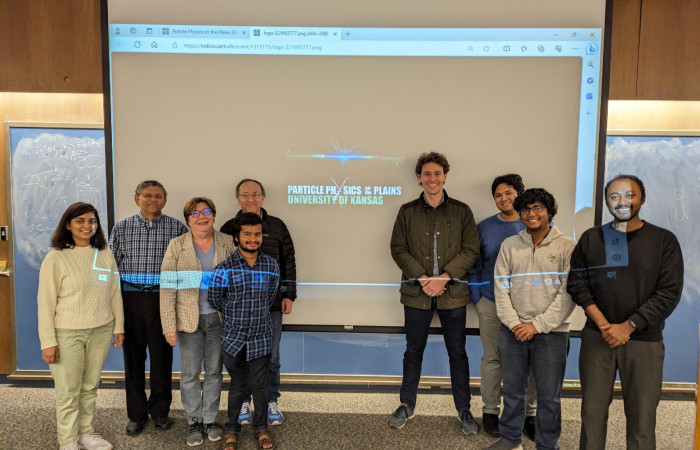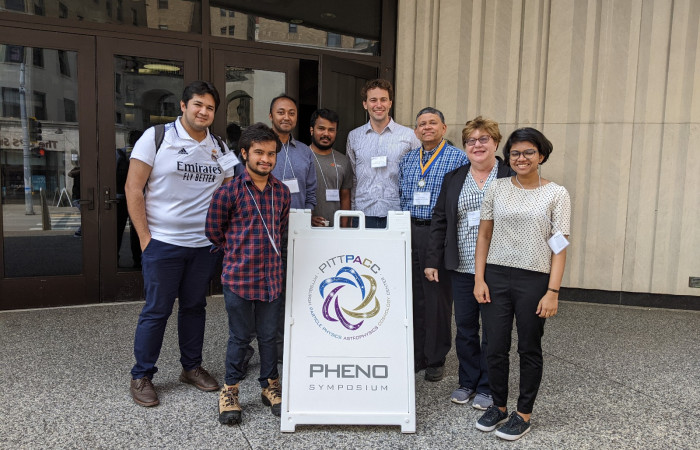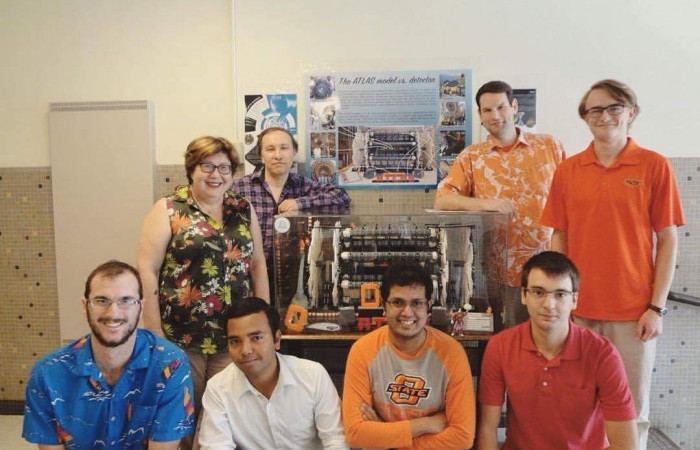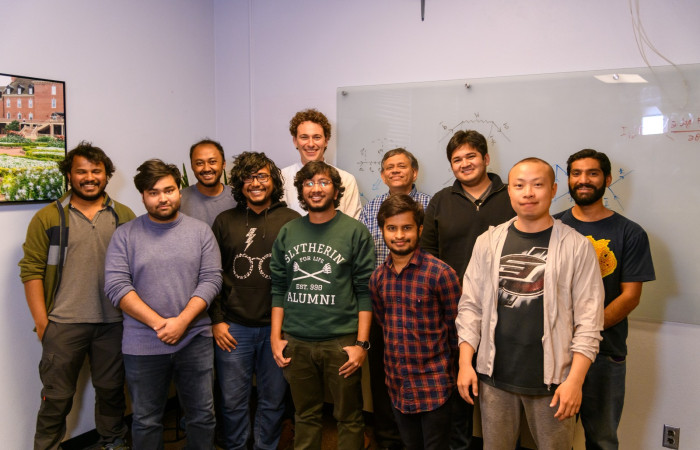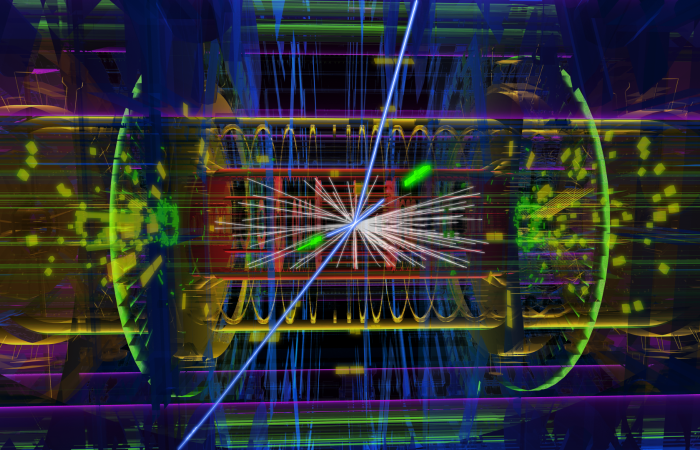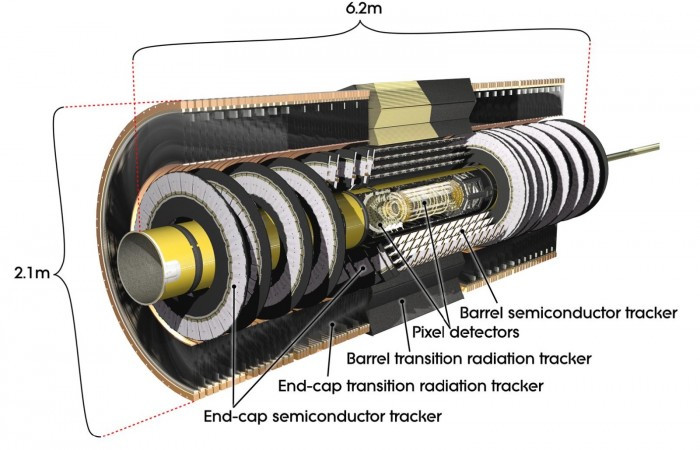OSU HEP Home page
Welcome to the website of the High Energy Physics Group at Oklahoma State University!
The aim of our research is to explain and explore Nature at her most basic level. Our current knowledge of elementary particles and their interactions (excluding gravity) is the Standard Model of particle physics. Originally developed in the 1970s, the Standard Model is one of the most extensively tested theories in physics. However, despite its success, the Standard Model cannot be the complete theory of the Universe. It does not include gravity, has no explanation for dark matter content of the Universe, and has no mechanism to generate neutrino masses. In addition, it fails to provide insight into questions like why there are three generations of fermions, why the neutrinos are so light, why the top quark is so heavy, etc. Our goal is to address these shortcomings by developing and testing well motivated extensions to the Standard Model.
Our theoretical research is focused on testing the Standard Model of particle physics, as well as suggesting and probing theories that go beyond the Standard Model. Our work spans a broad range of topics including Higgs physics, Neutrino physics, Unification of Forces, Dark Matter, and QCD. The group focuses on phenomenological explorations at the Energy Frontier, especially with the Large Hadron Collider (LHC), and at the Intensity Frontier, especially with the Deep Underground Neutrino Experiment (DUNE).
Our experimental program is involved in both measurements of known particles, like the top-quark, and searches for new particles, like charged Higgs bosons, additional quarks, or leptoquarks. Our research is carried out using the ATLAS detector at CERN (and previously the DO̸ (DZero) experiment at Fermilab). Our group has been involved in the construction of the optical readout of the IBL upgraded to the ATLAS Pixel system and the upgrade to the online monitoring software for the ATLAS Pixel system. We are also involved in the development and calibration of the b-tagging algorithms and studies of jet substructure on ATLAS.
ATLAS Public Webpage
ATLAS Collaboration Webpage
For anyone who's a bit rusty in particle physics, we encourage you to take The Particle Adventure, an award-winning interactive tour of the sub-atomic world.
Recent Preprints
Gravitational Wave Signatures of a Chiral Fermion Dark Matter Model
T. Abe, K.S. Babu, A. Kaladharan
e-Print: 2312.17203 [hep-ph]
Fermion Masses, Neutrino Mixing and Higgs-Mediated Flavor Violation in 3HDM with S3 Permutation Symmetry
K.S. Babu, Y. Wu, S. Xu
e-Print: 2312.15828 [hep-ph]
Predictive Dirac Neutrino Spectrum with Strong CP Solution in SU(5)L×SU(5)R Unification
K.S. Babu, R. N. Mohapatra, A. Thapa
e-Print: 2312.14096 [hep-ph]
Magnetar-powered Neutrinos and Magnetic Moment Signatures at IceCube
T. Cheng, H. Kuan, Y. Li, V. Brdar
e-Print: 2312.14113 [hep-ph]
New Directions for ALP Searches Combining Nuclear Reactors and Haloscopes
F. Arias-Aragón, V. Brdar, J. Quevillon
e-Print: 2310.03631 [hep-ph]
Non-linear top-Higgs CP violation
A. Bhardwaj, C. Englert, D. Gonçalves, A. Navarro
e-Print: 2308.11722 [hep-ph]
Returning CP-Observables to The Frames They Belong
J. Ackerschott, R. Barman, D. Gonçalves, T. Heimel, T. Plehn
e-Print: 2308.00027 [hep-ph]
News
- High Energy Physics group awarded $1.8M from DOE
- Ajay Kaladharan (PhD student) was awarded the OSU Foundation Distinguished Graduate Fellowship for 2023-24
- Joe Haley (Assoc. Prof) received the 2022 Oklahoma State University Regents' Distinguished Teaching Award
Seminars
- Alberto Navarro (Oklahoma State University), Quantum Information and New Physics Searches at the LHC, 04.19.2024
- Luke Vaughan (Oklahoma State University), Constructing and Calibrating Graph Neural Networks for Flavor Tagging Jets in ATLAS and CMS, 03.28.2024
- Takeshi Fukuyama (Osaka University), Models of the muonium to antimuonium transition, 02.09.2024
- Rachel Houtz (University of Florida), Discrete Goldstone Bosons, 02.08.2024
- Alice Bean (University of Kansas), Towards Neuromorphic Readout of Particle Tracking Detectors, 01.25.2024 (Zoom link)
- Sean Curry (OSU), Geometry of conformal submanifolds, 11.30.2023
- Omar Medina (University of Valencia; UC, Irvine), Quark-Lepton Mass Relations from Modular Flavor Symmetry, 11.16.2023
- Mikael Chala (University of Granada), The landscape of effective field theories, 11.02.2023
- Srubabati Goswami (Physical Research Laboratory, India & Northwestern University), From an impossible dream to the unreachable stars: the journey of the neutrino, 10.19.2023 (colloquium)
- Srubabati Goswami (Physical Research Laboratory, India & Northwestern University), The Fable of the Unstable Neutrinos, 10.16.2023
- Konstantin Matchev (University of Florida), Is the machine smarter than the theorist? A phenomenologist's perspective, 10.13.2023
- Konstantin Matchev (University of Florida), Machine learning symmetries in physics from first principles, 10.12.2023 (colloquium)





